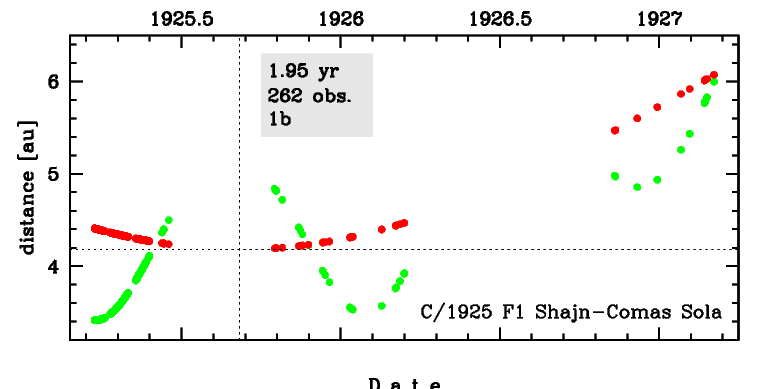C/1925 F1 Shajn-Comas Sola
more info
Comet C/1925 F1 was discovered on 22 March 1925, more than five months before perihelion passage, and was last seen on 4 March 1927 [Kronk, Cometography: Volume 3].
This comet made its closest approach to the Earth on 25 March 1925 (3.42 au), that is about three days after its discovery; it has second close approach to the Earth on 27 January 1926 (3.48 au).
Solution given here is based on data spanning over 1.95 yr in a range of heliocentric distances from 4.41 au through perihelion (4.18 au) to 6.07 au.
This Oort spike comet suffers slight planetary perturbations during its passage through the planetary system that lead to a slightly more tight future orbit in comparison to original one.
More details in Królikowska et al. 2014 andKrólikowska and Dybczyński 2017.
This comet made its closest approach to the Earth on 25 March 1925 (3.42 au), that is about three days after its discovery; it has second close approach to the Earth on 27 January 1926 (3.48 au).
Solution given here is based on data spanning over 1.95 yr in a range of heliocentric distances from 4.41 au through perihelion (4.18 au) to 6.07 au.
This Oort spike comet suffers slight planetary perturbations during its passage through the planetary system that lead to a slightly more tight future orbit in comparison to original one.
More details in Królikowska et al. 2014 andKrólikowska and Dybczyński 2017.
| solution description | ||
|---|---|---|
| number of observations | 262 | |
| data interval | 1925 03 23 – 1927 03 04 | |
| data type | perihelion within the observation arc (FULL) | |
| data arc selection | entire data set (STD) | |
| range of heliocentric distances | 4.41 au – 4.18 au (perihelion) – 6.07 au | |
| detectability of NG effects in the comet's motion | NG effects not determinable | |
| type of model of motion | GR - gravitational orbit | |
| data weighting | YES | |
| number of residuals | 463 | |
| RMS [arcseconds] | 2.75 | |
| orbit quality class | 1b | |
| previous orbit statistics, both Galactic and stellar perturbations were taken into account | ||
|---|---|---|
| no. of returning VCs in the swarm | 4973 | * |
| no. of escaping VCs in the swarm | 28 | |
| no. of hyperbolas among escaping VCs in the swarm | 0 | |
| previous reciprocal semi-major axis [10-6 au-1] | 25.15 – 34.06 – 41.89 | R |
| previous perihelion distance [au] | 350 – 1100 – 2400 | R |
| previous aphelion distance [103 au] | 47 – 58 – 77 | R |
| time interval to previous perihelion [Myr] | 3.2 – 4.6 – 7.5 | R |
| percentage of VCs with qprev < 10 | 1 | |
| percentage of VCs with qprev > 20 | 99 | |
| previous_g orbit statistics, here only the Galactic tide has been included | ||
|---|---|---|
| no. of returning VCs in the swarm | 4950 | * |
| no. of escaping VCs in the swarm | 51 | |
| no. of hyperbolas among escaping VCs in the swarm | 0 | |
| previous reciprocal semi-major axis [10-6 au-1] | 24.55 – 35.06 – 45.64 | R |
| previous perihelion distance [au] | 0.53 – 1.8 – 61 | R |
| previous aphelion distance [103 au] | 44 – 57 – 81 | R |
| time interval to previous perihelion [Myr] | 3.2 – 4.7 – 7.9 | R |
| percentage of VCs with qprev < 10 | 73 | |
| percentage of VCs with 10 < qprev < 20 | 7 | |
| percentage of VCs with qprev > 20 | 20 | |
